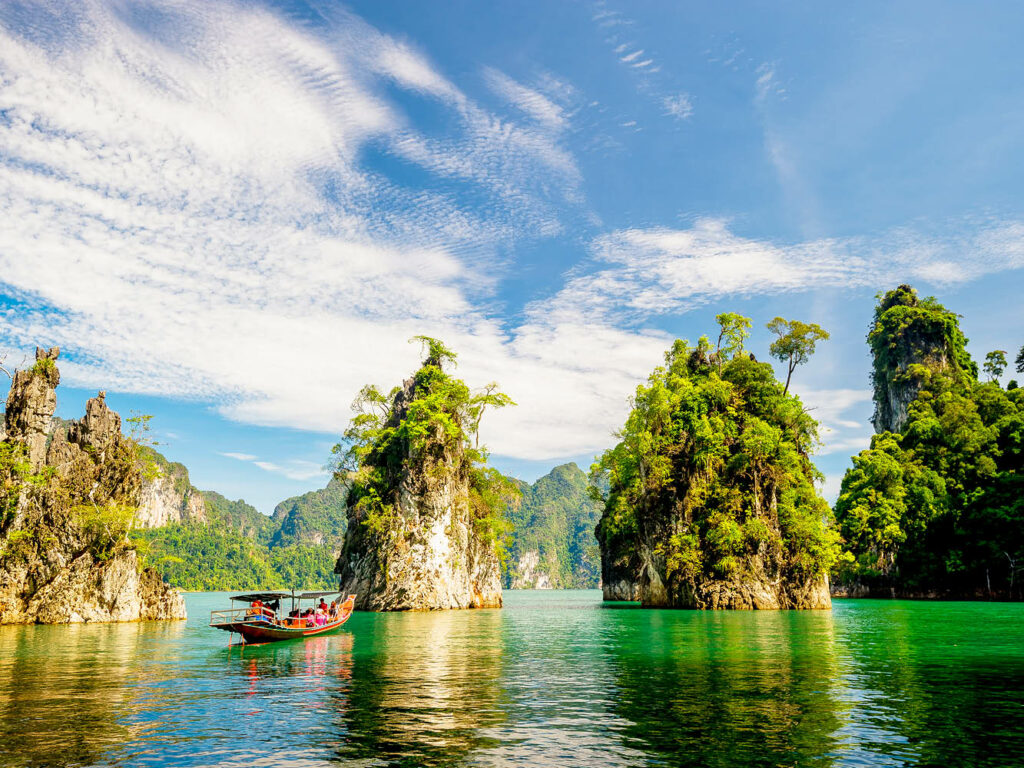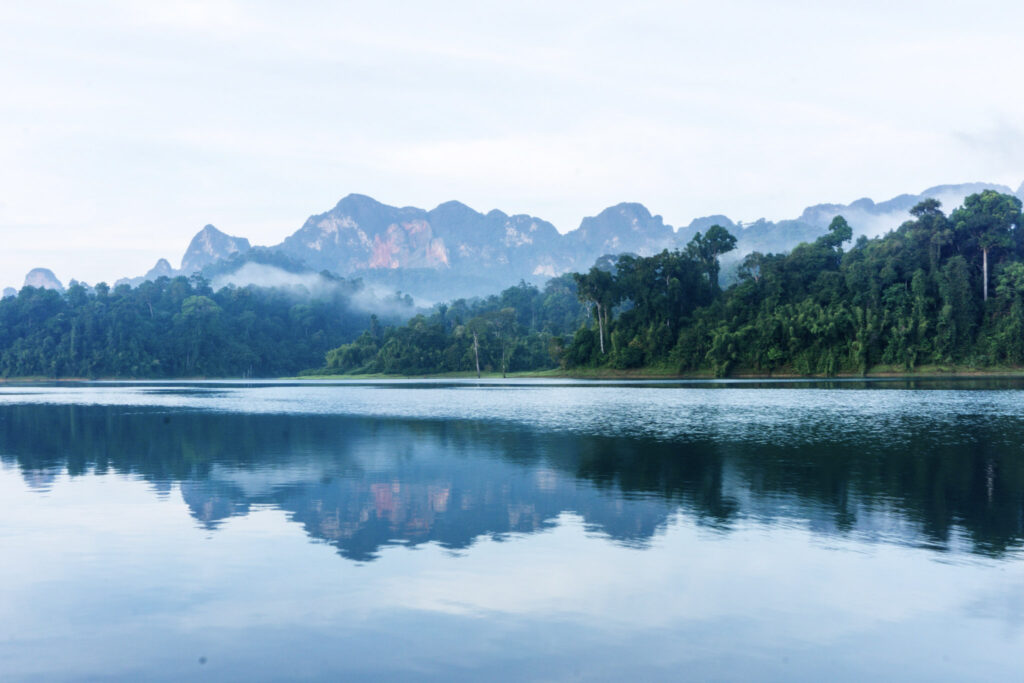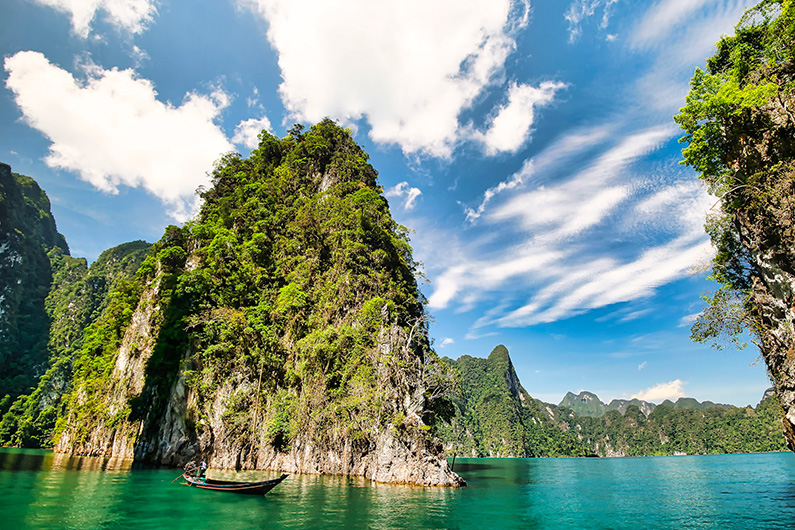Text : Stefan Christensen, Destination Asien
To travel without leaving an imprint on nature is difficult – but not impossible!

Let’s head to Cheow Lan Lake or, as it is also known, Rajjaprabha Dam in the gigantic Khao Sok National Park in Surat Thani Province.
Somewhat rested, we step off night train number 85 from Bangkok at Surat Thani Railway Station. A minivan picks us up for the one and a half hour drive to the pier by the dam.
Completed in 1987, the dam not only provides large parts of southern Thailand with electrical power but also is important for irrigation and fishing in the area.
Our group is comprised of six people who board the long-tail boat taking us to our floating bungalows at a far corner of the dam. While in route, we are presented with the amazing sight of the staggering rock formations around this huge dam.
Located in the 739 square kilometer Khao Sok National Park, there is plenty to see and do in the vicinity of the dam. The park is home to some of the oldest preserved rain forests in the world and the biodiversity rivals that of the Amazon Rain Forest.
Thanks to the Communists
The main reason Khao Sok escaped big scale logging, mining and hunting was a communist insurgency back in the seventies when large groups of communist insurgents hid out in the Khao Sok jungle. Thus, no one wanted to start logging or mining considering the risk of being killed by insurgents. Fortunately, immediately after the 170 communist insurgents were granted amnesty in 1982 and subsequently left the area, the whole biosphere was declared Thailand’s 22nd National Park.

The park is home to a wide variety of wild animals such as elephants, bears, deer, gibbons, macaque monkeys and wild boars. Also can be found just about any wild fruit growing in Thailand today. It is a biodiverse heaven for both flora and fauna.
Glamping
Glamping is a new word. It consists of two words, glamour and camping, that have been combined into one word to express the concept of upscale camping. It’s a growing trend worldwide and a convenient way to explore and discover nature without sacrificing too much of the convenience to be experienced in a luxury hotel.

A Glamping site usually consists of a pre-assembled sturdy safari tent, fully furnished with real beds, a proper seating area and a useable toilet with running hot and cold water. Electricity and hot water are often provided by solar panels. You can even charge your phone.
When we arrive at our floating glamping site, it is instantly clear that the whole resort can be dismantled and removed in less than 24 hours, leaving no trace. The environmental footprint is near zero. Food is served on a communal float that acts as a meeting point and restaurant. All food is included in the overnight price, thus providing a means to calculate exact amounts needed and to avoid waste.
In addition to excursions in the immediate lake area and in the surrounding national park, you can explore the man-made lake itself with its limestone cliffs and caves. You also can swim or paddle a canoe right from your bungalow. We, however, opted for an excursion in the mangrove swamps of Khao Sok National Park.
Snakes and Macaques
While on the boat tour through the mangrove swamp we spot a few different snakes, among them a mangrove cat snake that is resting in the tree above us. It’s a snake that is nocturnal and according to the captain on the boat only “a little poisonous”. Despite that information we opt to not rattle the tree branches when we pass under the sleeping snake.
We find not only snakes, but also a large number of crab-eating macaque monkeys. These monkeys live in matrilineal social groups built around 2-3 females, but the groups can consist of up to 20 monkeys.
Crab-eating macaques are also known as a long-tailed macaques for the obvious reason that their tails are actually quite long. They can be quite aggressive towards other animals and also to humans, so beware. We pass them at a safe distance.
Macaques are an invasive species. When they move into a new territory they pose a threat to the biodiversity because they force other species out of the territory. The mangrove swamp is their natural habitat, however, we are the invasive species here. As long as we keep track of our possessions such as handbags and cameras, items eagerly and easily swiped by the macaques, all is fine.
A trait that illustrates how closely related these amazing animals are to humans is that they are omnivore – they eat both plants and animals.
A Trek with Banana
The last day at the lake we opt for a walking tour of the jungle. it is not a very long or very complicated walk but wearing sturdy shoes (no flip-flops) and having a walking cane / stick are pretty much essential. The camp guide can whip up a walking stick for you with his machete in no time at all. During the walk we learn more about the surrounding natural habitat and the animals that inhabit it. This information comes from our extremely knowledgeable jungle guide, Banana. Yes her nickname in Thai is Banana, much to the amusement of our group. But she is well versed on all aspects of Khao Sok, especially the flora and fauna found here.
So if you want to come close to nature and leave a minimal footprint, try glamping in Khao Sok National Park – it is a unique adventure!
Read more about eco-tours in Khao Sok …
Share




